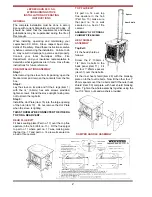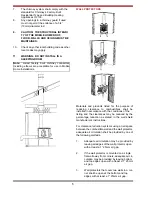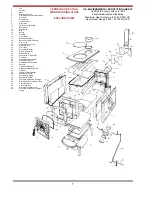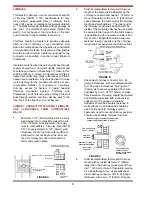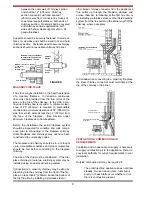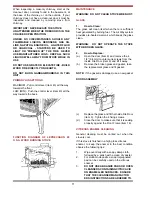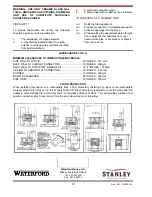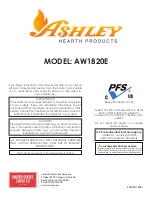
THIMBLES
Thimbles for chimneys or vent connectors should be
of fire clay (ASTM C 315, specifications for Clay
Flue Linings), galvanised steel of minimum thick-
ness of 24 gauge, or material of equivalent durabili-
ty. Thimbles should be installed without damage at
the liner. The thimble should extend through the
wall to, but not beyond, the inner face of the liner
and should be firmly cemented to masonry.
Thimbles should be located to provide adequate
pitch or rise of chimney or vent connectors and,
where the ceiling above the appliance is constructed
of combustible material, the location of the thimble
should provide minimum clearance required for the
connector as specified in section under Minimum
Clearances.
Insulation material used as part of wall pass-through
system should be of non-combustible material and
should have a thermal conductivity of 1.0 Btu. in./ft.F
(4.88 kg.cal/hr.m.c) or less. All clearances and thick-
nesses are minimums; larger clearances and thick-
nesses are acceptable. Any material used to close
up the opening for the connector should be of non-
combustible material. A connector to a masonry
c h i m n e y, except for System 2 (under heading
Chimney Connector System, Thimbles and
Clearances), shall extend to piece through the wall
pass-through system and the chimney wall to the
inner face of the flue liner, but not beyond.
CHIMNEY CONNECTOR SYSTEMS, THIMBLES,
AND CLEARANCES FROM COMBUSTIBLE
WALLS
1.
Minimum 3 1/2” (90mm) thick brick masonry
wall framed into combustible wall with a min.
of 12” (305mm) brick separation from clay
liner to combustibles. Fire clay liner (ASTM
C315 or equivalent) min. 5/8” (16mm) wall
thickness, should run from outer surface of
brick wall to, but not beyond, the inner sur-
face of chimney flue liner and should be
firmly cemented in place.
2.
Solid insulated listed factory-built chimney
length of the same inside diameter as the
chimney connector and having 1” (25mm) or
more of insulation with a min. 9” (230mm) air
space between the outer wall of the chimney
length and combustibles. The inner end of
the chimney length shall be flush with the
inside of the masonry chimney flue and shall
be sealed to the flue and to the brick mason-
ry penetration with non water-soluble refrac-
tory cement. Supports should be securely
fastened to wall supports and the chimney
length shall not penetrate the chimney liner.
8
FIGURE A
FIGURE B
3.
Sheet steel chimney connector, min. 24
gauge in thickness, with a ventilated thimble,
min. 24 gauge in thickness, having two 1”
(25mm) air channels, separated from com-
bustibles by a min. of 6” (150mm) of glass
fibre insulation. Opening should be covered
and thimble supported with a sheet steel
support, min. 24 gauge in thickness.
Supports should be securely fastened to
wall surfaces on all sides and should be
sized to fit and hold chimney section.
Fasteners used to secure chimney sections
should not penetrate chimney flue liner.
4.
Solid insulated listed factory-built chimney
length with an inside diameter 2” (50mm)
larger than the chimney connector and hav-
ing 1” (25mm) or more of insulation, serving
as a pass-through for a single wall sheet
steel chimney connector of min. 24 gauge
thickness, with a min. 2” (50mm) air space
Minimum clearance 12” (300mm) of brick
Minimum chimney clearance to
brick and combustibles 2” (50mm)
Minimum 12” (300mm)
to combustibles
Chimney connector
Fire Clay Liner
Masonry
Chimney
constructed to
NFPA 211
(230mm)
Minimum chimney clearance to sheet steel
supports and combustibles 2” (50mm)
Two ventilated air
channels each 1”
(25mm) constructed
of sheet steel
Minimum 6” (150mm)
glass fibre insulation
Two air channels
each 1” (25mm)
Chimney
connector
Minimum chimney clearance from masonry to
sheet steel supports and combustibles 2” (50mm)
Non-soluable
refractory
cement
Chimney
length flush
with inside
of flue
Masonry
chimney
constructed to
NFPA 211
Factory built chimney length
Air space 9” (230mm) minimum
Sheet steel
supports
FIGURE C


